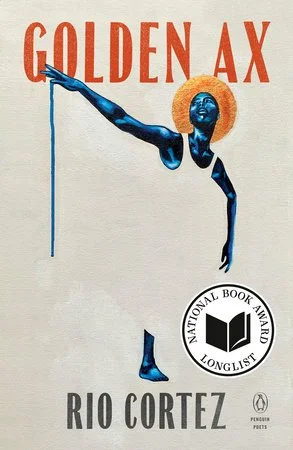Breanna Foskit Reviews Golden Ax by Rio Cortez
Born and raised in Salt Lake City, Utah, Rio Cortez is the New York Times bestselling author of The ABCs of Black History (Workman, 2020) and I Have Learned to Define a Field As a Space Between Mountains, winner of the 2015 Toi Dericotte and Cornelius Eady Chapbook Prize. Her honors include a Poets & Writers Amy Award, as well as fellowships from Cave Canem, Canto Mundo, The Jerome Foundation, and Poet’s House.Rio holds an MFA in Creative Writing from New York University. Since publication, Golden Ax has been longlisted for the National Book Award for Poetry.
Golden Ax brilliantly submerges the reader into Rio Cortez’s world and opens our eyes to neglected realities. In her collection of poems, Cortez structures the book by creating three sections: “Space Between Mountains,” “The Negro Pioneer,” and “Frontier Elsewhere.” She highlights how her family was an integral part of American histories and that people of color have been a necessary part of American religion, literature, and culture.
Cortez’s collection is inspired by the history of her family. The first section of her anthology focuses on the past and her family history. She has coined the term “Afropioneers” to describe her ancestors, some of the first African Americans to go West after the Reconstruction period. They moved to Utah where she spent her childhood, and where she discovered the long lasting legacy they left. Her family's contributions spanned across literature, religion, and written histories. Cortez referenced her family's shared memories of her ancestors: Paul C. Howell, the first black police detective in Utah, Abner Howell, whose testament helped convert many African Americans to Mormonism, and Byrdie Langdon, who self published her book Utah and the First Black Settlers to write her own collection of poems. She writes of this history:
“I am in a sweet place
And this sweet place
Has also been the sweet place
Of my people
It has been a timber wall
Built by hands, Black
And throttling backwards
Through time”
The next two sections of Cortez’ collection focus on the culmination of thoughts and feelings that lead her to make a move of her own to Harlem, New York. During these sections, she uses popular culture references to create a dichotomy between what has been available in mainstream American media and how Cortez viewed herself. By highlighting Black Creatives in places they have rarely been seen, she increases visibility and calls the reader to question why we haven’t seen more Black characters like Frasier Crane.
In the last two sections of Cortez’s collection, New York serves as the setting of some wonderfully ordinary moments. From washing her child’s dishes to living on a cul-de-sac, Cortez reframes everyday concepts into things to be experienced with regard. In the first section, Cortez considers, “whether it was aliens/ that brought Black folk to the canyons, valley” in Utah. Cortez says in an interview with Shondaland that an absence of written or told Black history inspired her to imagine her ancestors and herself being placed in Utah by spaceship. Her move to Harlem mimics her ancestors’ migration, but it offers some small reconciliation for her feelings in Utah by poeticizing prosaic aspects of her own life and casting her into new roles. New York's diversity and history are essential to the healing and growth illustrated in Cortez’s poetry. Because it is a hub of different people and cultures, it allows Cortez to transcend one role and become “Black Mary Wilkie” or “Black Annie Hall,” and to create a history centered by peace and beauty. In “Eden,” we see how this new home helps her rise to new heights:
“cul-de-sac, just as well, a saucer rising up
Up to the summit, it's possible I’ve never been
Higher, I feel it, I’m really Leaving now
Moving through the told story.”
Cortez’s own recollection of girlhood, family, and identity is deeply affecting and endears us to the extraordinary and mundane parts of her characters’ lives. These poems not only acknowledge but also celebrate aging, femininity, and motherhood. Her juxtaposition of sad realities and promising futures molds and mends the heart in an authentic, powerful way.
Breanna Foskit is an editorial intern for Hayden’s Ferry Review.
